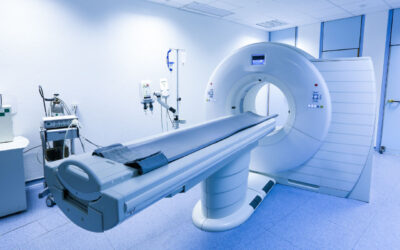
By Matt Skoufalos
In earlier days of medical imaging studies, patients were routinely given lead aprons to shield the parts of their bodies that weren’t involved in the study from ionizing radiation. At the time, that thinking was governed by concerns about the potentially adverse effects of irradiating sensitive areas of the body to avoid creating hereditary mutations. However, after decades of studies seeking to link radiation and human genetics, research hasn’t shown any evidence for that risk. Now, health care institutions worldwide are dealing with the work of changing their policies around patient shielding.
When a prophylaxis doesn’t offer the protection it once was thought to, how does the rest of the medical field adapt to the new evidence?
Medical Physicist Rebecca Milman, Ph.D., associate professor of radiology-radiological science at the University of Colorado Anschutz Medical Campus, said that, at her campus, the question of patient shielding arose in conversation with some of the school’s radiologic technologist students.
When her colleague’s reply was that the lead shielding “doesn’t really provide any safety for the patients, but it’s the way it’s always been done,” it prompted a conversation about the science behind that thinking. Upon further investigation, Milman said her group determined a number of professional organizations were evaluating the same question in terms of risks and benefits.
One such study, “X-ray shields going by the wayside: What you and your patients need to know,” by Donald Frush, M.D., FACR, FAAP, and Janet Reid, M.D., FRCPC, FAAP, which appeared in the March 2020 issue of AAP News from the American Academy of Pediatrics, described the institutional reassessment of the benefits of radioprotective shielding.
 As recently as 2019, the American Association of Physicists in Medicine (AAPM) issued a position statement recommending that lead shielding of patients’ genitals and pregnancies during X-ray studies need not be a routine practice, as it historically has been, Frush and Reid noted. Technological advancements, better understanding of radiation sensitivity in the gonads – and a lack of uniformity in their location within the body – are among key developments behind the shift in guidance.
As recently as 2019, the American Association of Physicists in Medicine (AAPM) issued a position statement recommending that lead shielding of patients’ genitals and pregnancies during X-ray studies need not be a routine practice, as it historically has been, Frush and Reid noted. Technological advancements, better understanding of radiation sensitivity in the gonads – and a lack of uniformity in their location within the body – are among key developments behind the shift in guidance.
From a technological perspective, the practice of shielding imaging patients from ionizing radiation first gained traction in the mid-20th century, Milman said. Amid studies of the after-effects of nuclear warfare in World War II, the U.S. Food and Drug Administration began to recommend patient shielding to prevent any adverse hereditary effects of exposing reproductive organs to radiation.
“They were concerned that if you expose the gonads to radiation that it would cause changes in the human gene pool,” she said. “They studied that very closely, and there’s just no evidence that that’s true in humans, even looking at these very large-scale studies in atomic bomb survivors.”
Another major development in the intervening years has been improvements to medical imaging technologies that has decreased the amount of radiation necessary for a high-quality image by more than 90 percent. In systems that use automatic exposure control, image detectors measure how much radiation penetrates the patient’s body to determine the intensity needed to generate a useful study. Inserting any radiation blocking materials into the field of study – say, a lead apron – could actually have the opposite intended effect and cause the automated process to intensify to attempt to penetrate the shielding.
“There’s this feedback loop that has been demonstrated to optimize how we use radiation imaging, but also image quality,” Milman said. “If you have a piece of lead in the field of view, it’s trying to look through it, and it actually puts out more radiation. That’s something that technologically didn’t exist in the 1950s, but that’s a concern with current equipment.”
Another concern with lead shielding is that sometimes the lead apron will cover up a part of the body that a technologist is trying to image. Furthermore, attempts to use shielding to cover gonadal areas might not be effective because of the significant natural variation in the body. Among a cross-section of female patients, for example, their ovaries aren’t always located in the same areas of the body, Milman said.
 “You’d have to cover the entire pelvic area,” she said. “If the parts of the body you want to see are covered with lead, then you’d have to either retake the image, which is more radiation, or send the suboptimal image to the physician. If the physician isn’t able to see what they need to see in the image, then there was no point in doing it in the first place.”
“You’d have to cover the entire pelvic area,” she said. “If the parts of the body you want to see are covered with lead, then you’d have to either retake the image, which is more radiation, or send the suboptimal image to the physician. If the physician isn’t able to see what they need to see in the image, then there was no point in doing it in the first place.”
Additional studies around radiation shielding of pregnant imaging patients led to a similar, potentially counterintuitive conclusion: shielding the fetus from ionizing radiation doesn’t have the intended effect.
“Most of the exposure to the fetus is from scatter radiation generated inside the mother,” Milman said. “Outside that imaging field of view, the amount of radiation falls off quickly. So, in that case, you’re really not able to shield the fetus from the radiation it’s being exposed to. You’re going to get the most benefit if the shield is right up against the imaging field. The problem is, once you get closer and closer to that field of view, there’s a greater likelihood that lead ends up in your image,” potentially interfering with the image quality or radiation dose.
But even if lead shielding only has a psychological placebo effect for patients who are concerned about the impact of ionizing radiation, why not just leave things as they are? Milman said conversations in the field about continuing to shield have generally settled into two schools of thought.
“One is that it doesn’t do any good, but it can reassure patients,” she said. “The other side is, if we continue to shield patients when it doesn’t do any good, we’re saying that we’re providing some protection because there’s a risk, although the risk doesn’t actually exist.
“This goes back to this overall public perception about radiation, and fear of radiation, and it seems like an academic debate on the surface,” she said, “but the more you talk to radiologists, physicians, medical physicists and technologists, we run into this all the time. The risk from the radiation is much lower than not having an accurate diagnosis.”
“It’s really difficult to watch somebody make a decision based on a fear that we know isn’t a risk, or is such a small theoretical risk that they’re overlooking the bigger picture,” Milman said. “It kills me every time I talk to a patient and they don’t want to have this imaging exam because the risk associated with it is so exaggerated; so deeply ingrained.”
Determining a path forward for patient safety, while both acknowledging the best available scientific evidence, and preserving patient autonomy to make medical decisions based on risks and benefits, is the next stage of the conversation. In addition to the science behind the refined guidance, Frush and Reid also addressed the other end of the issue; namely, the emotional reaction from patients who have been conditioned for decades to have a healthy respect for the impact of ionizing radiation on soft tissue.
“Exceptions can be made if a parent/caregiver requests a shield, and it is of psychological benefit,” they wrote. “In these situations, the radiology practice should have guidelines and communication strategies to enable the requesting caregiver to understand the benefits and disadvantages of shielding.”
“It’s so deeply ingrained,” Milman said. “It ties into this overall fear of radiation, both in popular culture and our day-to-day lives.”
“It’s OK to have a gut reaction to something,” she continued. “There are many, many reasons why humans go through that process. Risk perception is a very, very tricky sort of thing, within the health care community especially. It’s about being willing to step back and say, is this still the best thing to do?”
Even throughout the broader medical community, Milman acknowledged “a certain discomfort” with the notion of not shielding patients during X-ray studies, particularly among physicians who refer patients for imaging exams, and who many not have training in radiation safety themselves.
 When UCHealth changed its policy regarding patient shielding in 2018, she said that staffers sat down with technologists to script some prepared responses to offer patients who questioned the new procedures. Anecdotally, at least, very few people pressed the issue.
When UCHealth changed its policy regarding patient shielding in 2018, she said that staffers sat down with technologists to script some prepared responses to offer patients who questioned the new procedures. Anecdotally, at least, very few people pressed the issue.
“The technologists said some people asked why we weren’t using shields anymore, and then 98 percent of the time, they’d move on,” Milman said. “There really were very, very few patients who said, ‘I still want to be shielded,’ and in those cases, wherever possible, we’d still shield them.”
“Most of the time, patients wanted to make sure that not using a shield was deliberate,” she said. “A lot of the time, what they really want is some reassurance that someone is paying attention. When I explain that we’ve got a whole team monitoring the amount of radiation this equipment is using, knowing that someone is paying attention to it, a lot of the time, that is reassuring for patients.”
Elsa Pearson Sites, MPH, is policy director for the Partnered Evidence-based Policy Resource Center (PEPReC), a research evaluation center affiliated with the Boston University School of Public Health. Sites described how her facility has worked to translate and disseminate the policies and research around patient radiation shielding, and the efforts that go into driving broader cultural shifts when new evidence changes medical guidance.
“It’s really hard to get people to do things that were once deemed very risky, and trying to tell them it’s not,” she said. “It’s classic human psychology: despite the evidence, it feels like the needle’s barely moving.”
In the past year, Sites pointed to growing acceptance of the shift in thinking around radiation shielding from policy changes at medical organizations like Dartmouth and Yale updating their patient guidance. An interesting outlier persists in the dental community, in which lead aprons are routinely placed on patients during head X-rays. But she believes that if anything’s going to advance the conversation, it’s greater patient education.
“That disconnect between what the medical community is doing and what the dental community is doing is going to be a very challenging public health conundrum,” Sites said. “If you’re getting shielded from head to toe at the dentist, and your doctor is putting you flat on the table, that’s confusing. I’m not sure it’s the medical community’s job to get the dental community onboard, but I think they have to have a seat at the table, and that’s what’s missing: open communication across parties.”
In seeking to unify the variety of perspectives around this issue, or any such issue, Sites said that messaging should emphasize clarity, simplicity, and anticipate questions, concerns, and disagreements with measured respect. She advised a tone that walks the line between addressing concerns without heightening fears.
“Anticipate that people will have questions and concerns and disagree, and respect that, and be ready to stand behind the evidence,” Sites said. “Be able to be clear, concise, simple, and evidence-based, but also respectful of pushback.
“It’s really hard when authority figures in your life change their mind,” she said. “It’s human psychology at work, and it’s just fascinating.”









